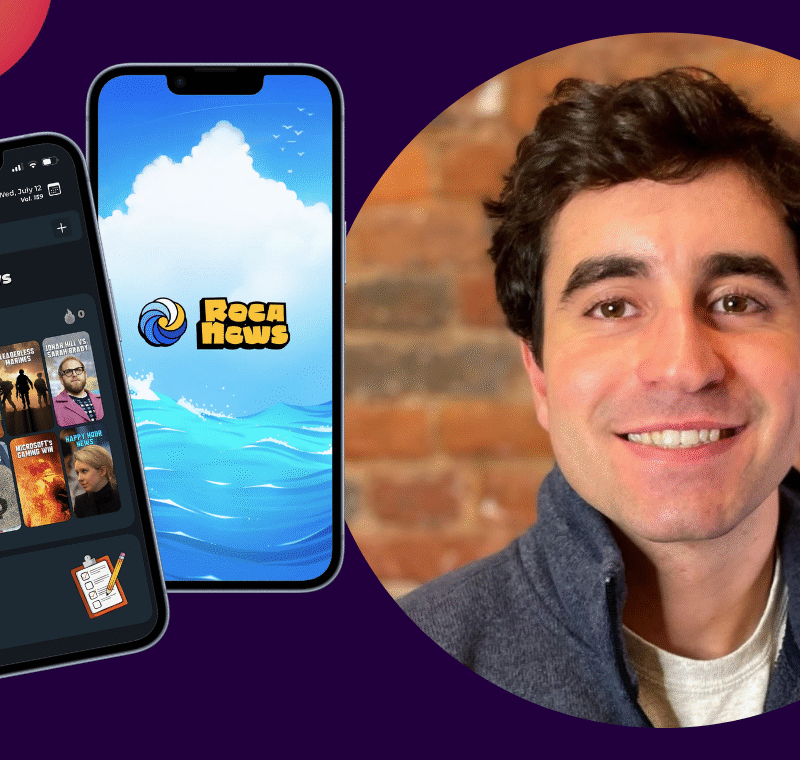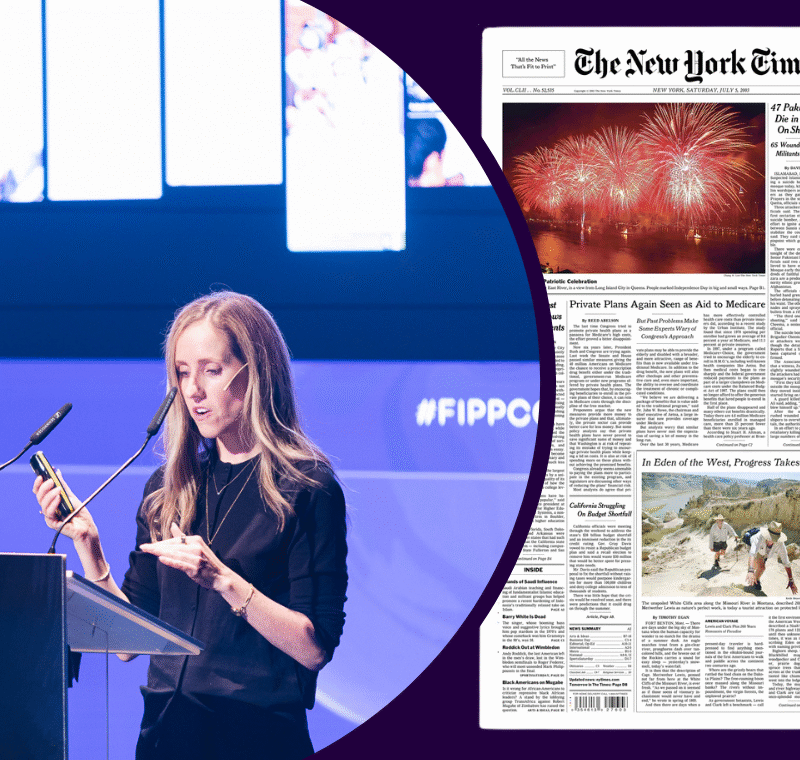How relevant do you want to be for your readers? New metrics prove, WhatsApp could be your secret weapon.
No understatement, but with only eight per cent share the US can’t be called an important WhatsApp market. Instead European countries like Spain (70 per cent), Italy (62 per cent), The Netherlands (61 per cent) and even Germany with 57 per cent have taken the front seats according to data from GlobalWebIndex in their Q4, 2014 report. Still a rising star, WhatsApp has avoided to monetise its huge user base by selling advertising so far. Instead it makes money with subscriptions only. Probably one of the reasons why its Value per Active User lies at US$42.22, far below that of Twitter (US$83,53), LinkedIn ($84,95) or Facebook with its outstanding $141,32. But what does that say about its value for publishers and journalists alike?
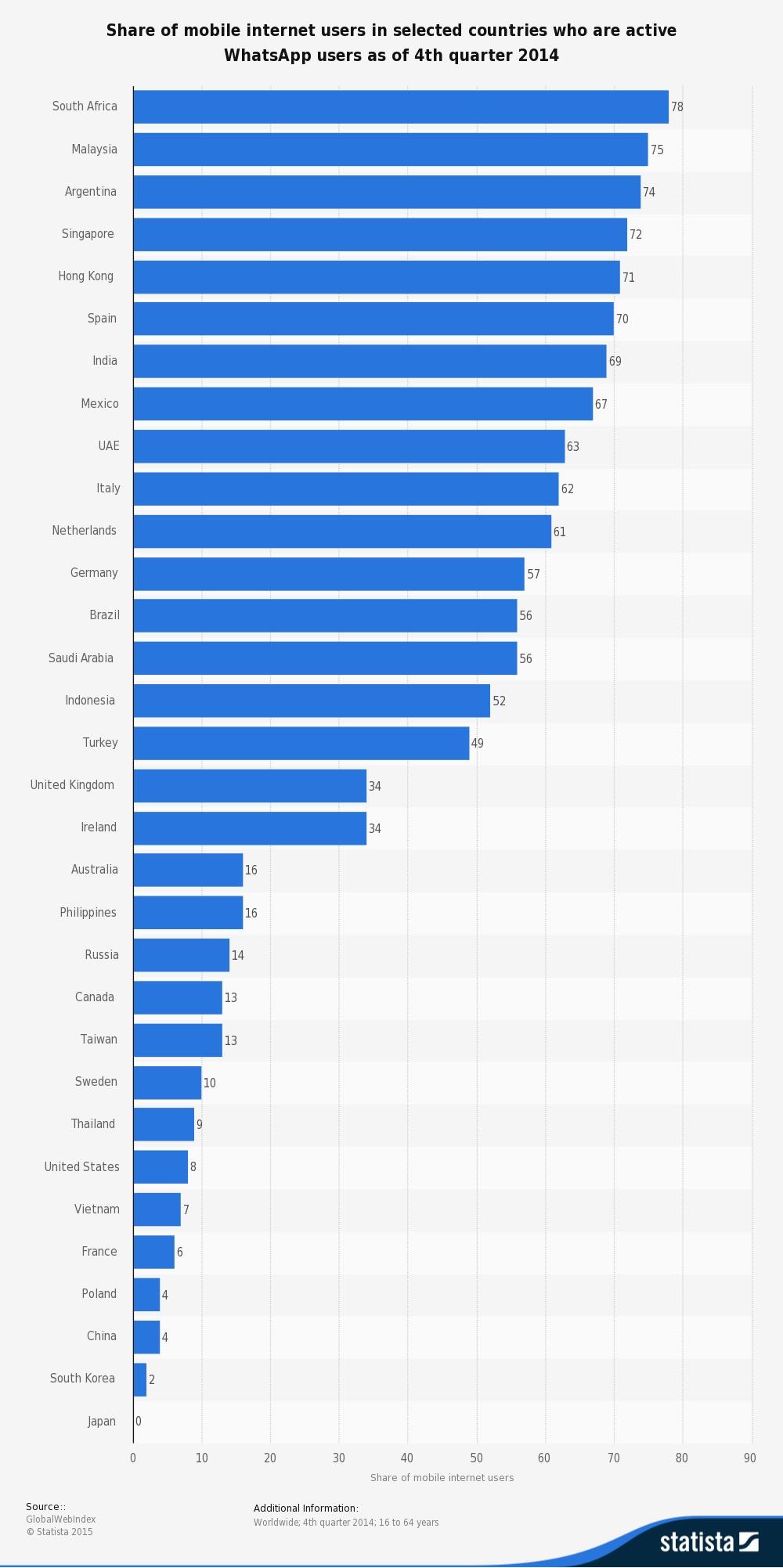
[Chart: Share of mobile internet users in selected countries who are active WhatsApp users as of 4th quarter 2014]
Short look back. Facebook acquired the instant messaging app February 2014 in a staggering $19bn deal. At that time already 400m user strong, WhatsApp claimed to grew one million new users per day reaching out for the ultimate goal of one billion users. A magical benchmark as Mark Zuckerberg noted.
“WhatsApp is on a path to connect 1bn people. The services that reach that milestone are all incredibly valuable” (Mark Zuckerberg)
It didn’t take the startup very long – no wonder with that remarkable growth rate – to reach 700m users in January, and recently 900m in September. To reach the one billion mark is just a matter of time and no doubt, it will happen pretty soon. As if this wasn’t enough, Juniper Research compared the share of messaging apps such as WhatsApp or LINE with SMS, MMS, mobile email and other messaging options and found that instant messaging accounts for 75 per cent of all mobile messaging traffic. Who’s not using it?
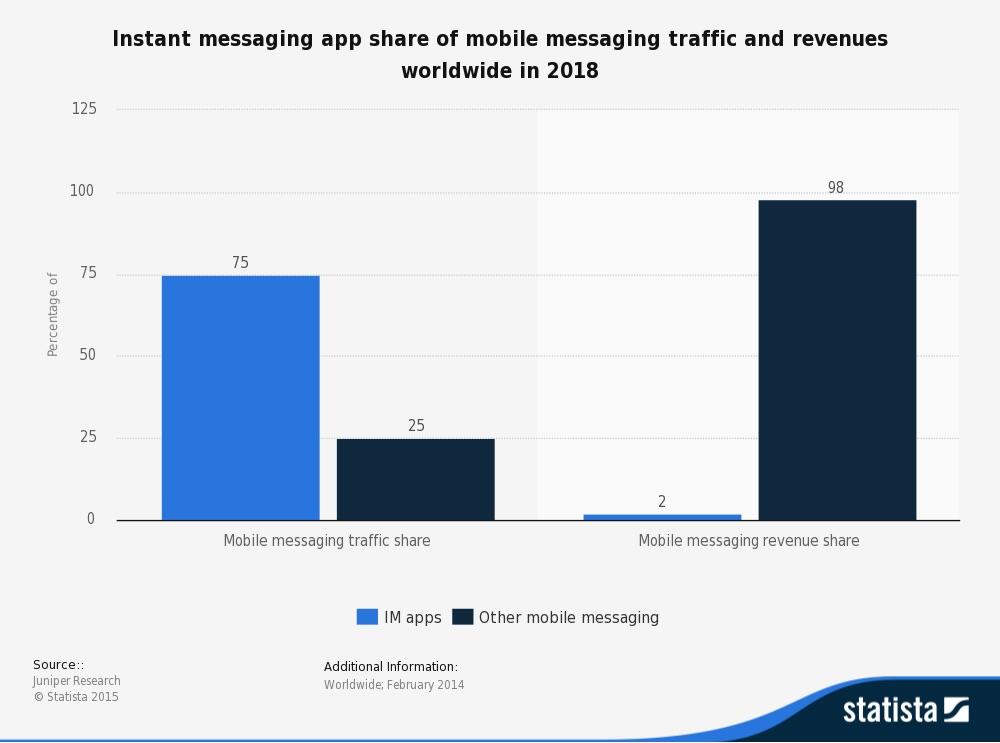
[Chart: Instant messaging app share of mobile messaging traffic and revenues worldwide in 2018]
WhatsApp users enjoy free service in the first year, but have to pay $0.99 if they want to extend the subscription. From text with links, to photo, video or audio messages users can select from a variety of options to share content, to stay in touch and to continue the dialogue at eye level. It’s this private and direct communication approach, why WhatsApp stands out from social networks like Facebook and Twitter and their public timeline feature. WhatsApp takes mobile communication back into users’ private sphere, an environment, in which advertising is not welcome. It’s its simplicity which users love and the ability to exchange information from person to person (P2P) either for free or at least at a very low price.
In addition WhatsApp offers the distribution of content either among many or one-to-many with its group feature and its recently introduced broadcast lists. Having primarily private users in mind not news or publishing organisations, WhatsApp’s technical restrictions are tough and limits are very low of what makes a group or how many can be on a broadcast list. Groups can’t have more than 100 members and broadcast list not more than 256, which makes it (not really) impossible to address larger audiences. Both, groups and broadcast lists serve different purposes of course. While broadcast lists were introduced to enable one-to-many communication, groups instead encourage communication at eye level.
Without workarounds or the help of third parties it wouldn’t be possible to reach larger audiences. Lacking an official API and having tough terms in place there is no chance to automate the distribution of content. Any automated service would violate its terms unless it’s capable to mimic human behaviour and human interaction speed.
WhatsApp Terms §3, C: “You agree not to use or launch any automated system, … that accesses the Service in a manner that sends more request messages to the WhatsApp servers in a given period of time than a human can reasonably produce in the same period by using a WhatsApp application, and you are forbidden from ripping the content unless specifically allowed.”
Some service providers have launched web based services to enable the management of conversations on WhatsApp despite their knowledge that they are operating in a grey area. They help users to manage larger lists without all the burden of too much manual work it has been so far and make sure that the distribution of content between lists will be managed automatically and appropriately without risking the accounts of their clients to get banned. The challenge though remains the same. WhatsApp has disabled mass communication for a good reason and forces publishers to rethink their content distribution approaches. Stop thinking in big numbers and start to consider more intense communication in a more personal relationship environment as your primary goal.
That makes it a perfect tool for customer service. Questions can be asked, which wouldn’t be posted in a public setting. The audio message feature encourages a more personal style and video and or photo posts can guide users in how to use products and services or can be arranged in form of of how-to guides. The overall costs to maintain and operate a “WhatsApp call centre” are pretty low and as long as the message is perceived as highly relevant, reach will be guaranteed. Promised.
Customer service is not the only way brands make use of WhatsApp today. Some media organisations also use it for sourcing or many-to-one services, collecting the content from citizen journalists in search for the next breaking news story. It’s this ability to turn into an effective back channel which makes WhatsApp interesting for news organisations and public broadcasters alike. It turns the service into an exciting sourcing tool as Konrad Weber of Swiss public broadcaster SRF explains in an interview by Daniel Bouhs, but with the risk of such content to pass by unnoticed. Questions like who owns the content and the verification challenge will be high on the agenda in return.
Another exciting opportunity for publishers is WhatsApp’s share button. Usually implemented to be invisible for desktop users and only accessible by those accessing a website on tablets or smartphones, it provides a great way to tap into the world of your mobile visitors. With 50-70 per cent of audiences accessing sites via a mobile device, news sites would be well advised to introduce this viral feature on their pages as well. You can only win, and it won’t hurt.
Joshua Benton of Nieman Lab made a compelling case for its power, describing the firsthand experience of Spanish soccer club FC Valencia, after they introduced the feature on their website. Facebook (35 per cent) and WhatsApp (33 per cent) share buttons were used nearly equally leaving Twitter (19 per cent) and Google+ (13 per cent) far behind. Clicks on WhatsApp’s share button resulted in 69 per cent share in the visits this kind of action produced (Facebook 15 per cent, Twitter 22 per cent, and Google only three per cent; mobile audience only). It is also a reminder that news brands have to take their cultural context into account by localising their audience growth initiatives. For FC Valencia it made perfect sense to integrate WhatsApp functionality with respect to a remarkable high penetration rate of 70 per cent in Spain. Cultural habits vary and it is not necessarily Facebook dominating each market.
But what click rates can publishers expect and what are the consequences? – Pylba, a Munich based IT startup and owner of WhatsApp management platform InstaNews recently released interesting analytics which shed some light on what has been a well kept secret so far.
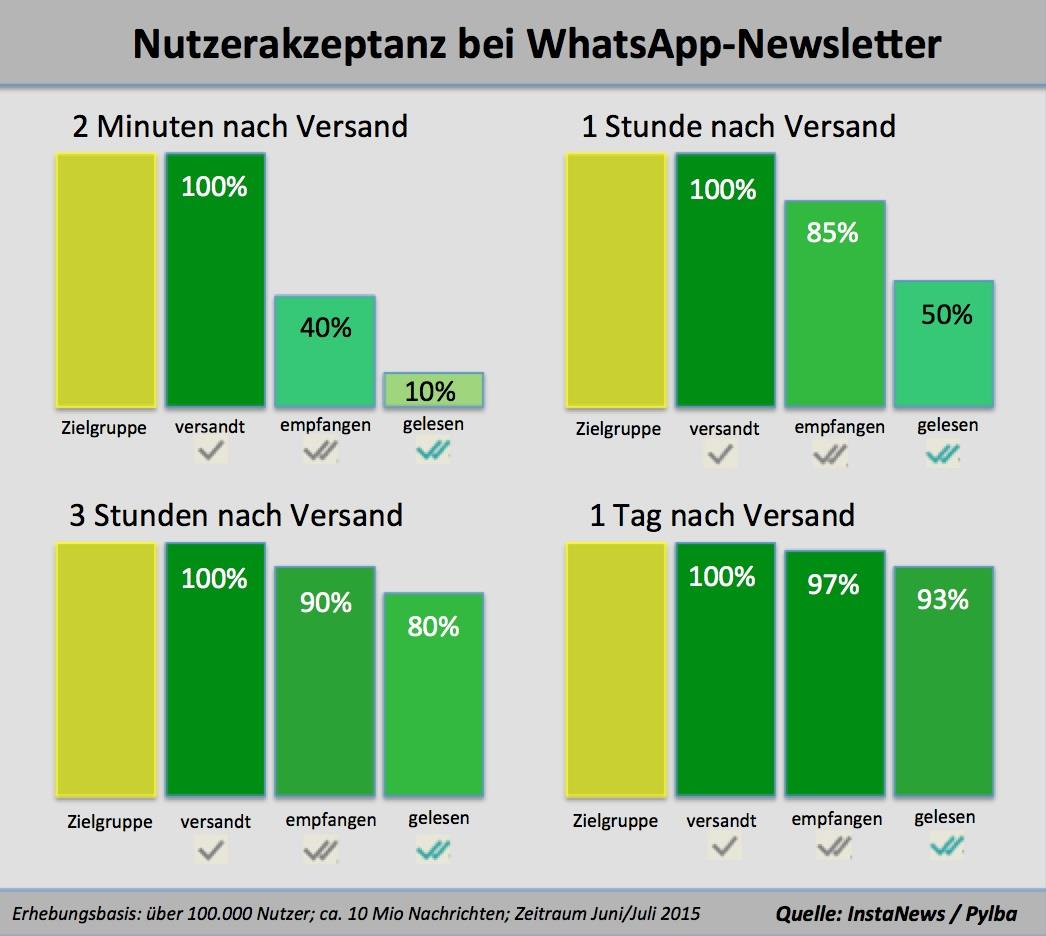
[Chart: Nutzerakzeptanz bei WhatsApp Newsletter]
On base of a sample of 10m messages and 100,000 users Pylba found 80 per cent of the WhatsApp audience can be reached within 3 hours after publishing of e.g. a “newsletter,” a post, which contains multiple headlines and links. More than 93 per cent can be reached until the end of the day. Numbers which make perfect sense, since users have to actively opt-in to receive messages, willingness to read is therefore high. But be aware: sending mass messages would be counterproductive. Pylba warns to send more than a maximum of three messages per day. More would lead to significantly higher drop out rates. Who wants to be spammed by “friends” in a private environment?
Pylba found that nationwide platforms with a user base in the 5-6 digits range, can achieve high clickthrough rates (CTR) of 10-20 per cent with single posts, in case of newsletter-style posts even 25-50 per cent. They found that users are more willing to read a post containing several text-link pairs than reading multiple single posts. Furthermore it is in the hand of the media brand to make its content highly relevant and therefore more inviting. Regional offers, the second segment they had a look at, were even more successful, due to the local content they usually provide they were able to achieve +10 per cent higher CTRs than those of nationwide platforms, in some cases resulting in up to 80 per cent clickthrough rates. For comparison: special interest magazines achieve CTRs up to 30 per cent with their newsletters and a highly targeted content approach.
Should you give WhatsApp a try? Definitely worth it to test it!
More like this
Publishers love Whatsapp’s potential, but struggle with execution




